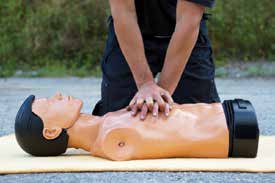Adult Cardio-Pulmonary or Cardio-Cerebral Resuscitation?
All people in Collier County should learn to save a life!
Cardio-pulmonary resuscitation (CPR)is a technique that has been in existence since the 1950s. It was the technique of choice to help people in cardiac arrest. Despite this technique, the overall survival rate has always been low.
In 2003, Dr. Ewy, and the Sarver Heart Center Resuscitation Research Group (and the University of Arizona) challenged the CPR guidelines because of the inadequacies for primary cardiac arrest. Traditionally the thought was to get oxygenated blood to circulate so breaths were used in a coordinated manner with chest compressions in an attempt to get oxygen to the lungs and then circulate-thus, cardiopulmonary resuscitation. It was not good enough.
Dr. Ewy developed a more advanced technique called the cardio-cerebral resuscitation (CCR).
Cardio-cerebral resuscitation recognizes that the most important organs that need oxygenated blood are both the heart and
brain. Thus, assuming that the individual collapses and was breathing just prior, there should be oxygen in his blood.
 This newer method is designed to get the blood that contains oxygen in it and deliver it throughout the body so that the oxygen can be used to keep the organs alive until professional emergency help is delivered. Think about priming a keg of beer. If you stop the pumping you lose that force of the prime….thus there is no more interruption of the compressions so the closed circulation system has a chance of circulating the blood and the heart and brain can get enough oxygen to survive. It takes 50
This newer method is designed to get the blood that contains oxygen in it and deliver it throughout the body so that the oxygen can be used to keep the organs alive until professional emergency help is delivered. Think about priming a keg of beer. If you stop the pumping you lose that force of the prime….thus there is no more interruption of the compressions so the closed circulation system has a chance of circulating the blood and the heart and brain can get enough oxygen to survive. It takes 50
uninterrupted compressions to build up the prime in this system. The new technique is hands-only for adults with no breaths and at the rate of 100 beats per minute. Traditional CPR has used the 5:1 or 30:2 –compressions:breaths.
Dr. Robert Tober, the Director of Emergency Services in Collier County, has worked closely with Dr. Ewy. Collier County has been using this technique for the last eight years and much thanks is given to Dr. Tober for his perseverance and dedication to this passionate topic despite resistance to change. Dr. Tober stated that in the first year Collier County doubled its survival rate.
Progressing, The American Heart Association currently recommends the hands-only technique.
This technique is now backed with literature and if the compressions are given correctly at the rate of 100 beats per minute which equates to the beat of the disco song, Stayin’ Alive, this can double or even triple the survival rate. Now, more counties are following this protocol.
The problem with resuscitation techniques is that in the past many people would not get involved because either they did not know the techniques or they did not want to provide breaths to another person. Now in the adult the rate and depth of compressions is key and not breaths!
Cardiac arrest in adults is the number one killer. One in four of us will witness at least one arrest in our lifetime and we are
ALL DEPENDENT ON BYSTANDERS to save us!
It is time to catch up to the new CCR method. Fitness Together implemented the teaching of this technique into their fitness
training programs. After all, it is not easy to perform consecutive compressions but it is worth doing them to save a life.
As a community service, Fitness Together in Downtown Naples can demonstrate and allow you to try this new method over the
summer months. In addition if you want to seek certification for the new technique then you can contact the American Heart Association.
Please feel free to call FT at 239.263.9348 for further information or visit www.cprrsqassist.com. Help to contribute to the success of Collier County and pass the word! Be prepared.
To Your Health!


Leave a Reply
Want to join the discussion?Feel free to contribute!